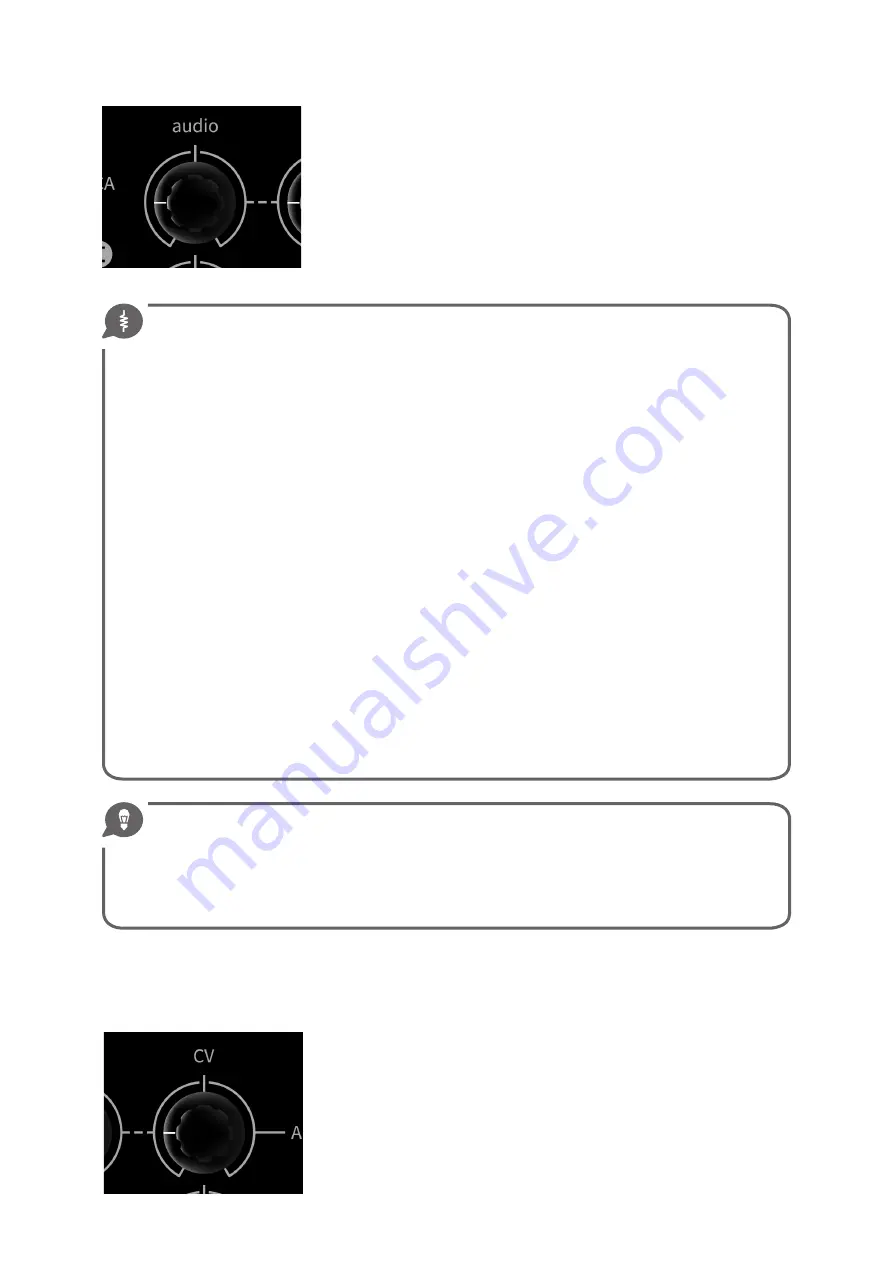
Audio is the control which indicates the level of the signal injected into the
singular filterboard. Small signals need high values which mean more noise
flowing into the circuitry. A careful balance of the source output level, this
control and the
STACCATO/CONTINUO
pot can help to obtain productive-
clean tracking.
Allways remember the good old rule MORE GAIN = MORE SUFERING = MORE
DISTORTION = NASTY SOUND DESIGN
The Preamplifier Circuit
The three preamplifiers incorporate a circuit design from the 1970s hosted in the early hi-end
Cambridge Audio systems. The maximum gain is set to +16dB to amplify a 150mV line input to approximately
1V with a small safety margin. If you want to overload it, however, this precautionary headroom is easily
fill up by a small increment of the external input level. In most modulars and hi-end synthesis devices
this 150mV level is rather low and you can easily overload the preamplifier stage since most systems
have oscillator's levels even at 5Vpp. Other weaker sources maybe need some sort of level push-up, but
it's rare. At the time of the preparation of this document we have tested this preamplifier design with the
following synthesis sources: Minimoog Voyager XL, Moog Slimphatty, Synthesizer.com Q106, Q141, Q112
and Q108, Oakley MU VCO, Arturia Minibrute, Roland MC909, Roland MC808, Roland TR808, Korg MX1,
Korg MS-10 (1978), Korg MS-20Mini, an original 1982 Formanta Polivoks, Waldorf Rocket, Waldorf Blofeld,
Access Virus TI, Yamaha S70XS, Siel Orchestra, Davoli Davolisint, an original Binson Echorec, MRL Lord of
the Ring, MRL ChatterBoxResonancenator, Kinetik Laboratories GORT the Robot, Protean and Dao, Grendel
Dronecommander, Buchla Easel, Metasonix D1000 and D2000, MFOS Minisynth, LittleBits SynthKit and even
with a Doepfer A-143-4 Quad VCLFO in VCO mode (circa 8,5Vrms).
In all the circumstances, except for the well-know very-low Davoli's output level, the behavior of the
VERTICE's input stage is optimal and the range until full distortion is larger than most consumer and pro
audio devices.
The control law offered by this circuitry is logarithmic, going from
-40 to +16 dB rms and the difference
between the A-board preamp stage and the equivalent B or C is minimal, about 0.3-0.4 dB maximum, which
is not perceptible in normal audio applications.
This is a solid low noise configuration that can manage every sort of audio signal with reliable and almost
transparent response.
The noise performance of this design going from
-114,5 to -90,0dBu at full volume. The produced noise at
this last setting may look a bit too much but at unity gain level it is set well below -100dBu, or more exactly
at
-107,5dBu, which is quite good considered the consequent circuitry (the very noisy and almost totally
passive filterboards) and the commons applications required (e.g.. tracking, classic subtractive synthesis,
droning etc.).
Hi-level audio signal distortion
On the other hand at full volume configuration there are great chances to overload the following
filterboard circuitry, with all the THD consequences. Not be afraid of that: VERTICE can afford very high signal
levels and it must be forced to work in this zone, making it a very powerful distortion machine.
The idea is to create more harmonics after the input stage than in the original timbre and then cut them
out. It's a simple but efficient way to obtain really rich and creative sound manipulations and to amplify the
beating between multiple sound sources.
CV means Control Voltage. It's the name of the standard voltage range
utilized since the sixties in synthesizer architecture. This pot identifies the
level of the related CV signal injected into each filter or into the Master Cutoff
control.
The attenuation law of this section is almost linear.
THE COMPONENTS
[
33
]
Содержание Vertice
Страница 1: ...USER S MANUAL...
Страница 2: ......
Страница 5: ...Dedicato a Walt Bruno e Lorenzina con immenso amore Stefano...
Страница 68: ...Ratio et Cogitatio Unicam Fidem Sunt...
Страница 69: ......
Страница 70: ......






























